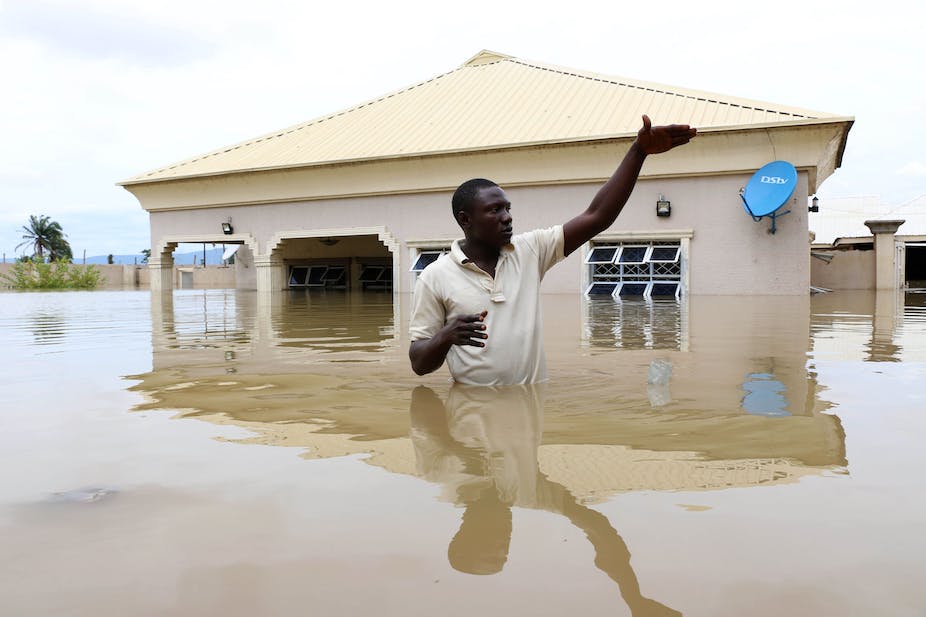Late last week, Nigeria confirmed plans by authorities in Cameroon to release water from the Lagdo Dam, raising fears in residents in the states around the River Benue.
The confirmation was in a letter by the Nigerian Ministry of Foreign Affairs to the National Emergency Management Authority or NEMA.
In the letter signed by Umar Salisu, the Director of African Affairs, the ministry confirmed the “receipt of a Note Verbale from the High Commission of the Republic of Cameroon informing that Cameroonian officials have resolved to open the flood gates of the Lagdo Dam on the Benue River in days ahead due to the heavy rainfall around the Dam catchment area in Northern Cameroon.”
The letter further reads that “according to the note, it is pertinent to note that when the release of water becomes necessary, the authorities of the Lagdo Dam will be releasing only modulated variable small amount of water at a time to mitigate and avoid damages that the released water may cause along the River Benue basin in both Cameroon and in Nigeria.”
The Lagdo Dam on the Benue River forms a natural border between the two countries and is a crucial source of hydroelectric power and water storage for Cameroon.
The Benue River flows into Nigeria, and any sudden increase in water volume could lead to devastating floods that inundate communities and displace populations. So, whenever the dam releases water, it causes flooding in low-lying areas and impacts Nigeria’s logistics and food security.
In 2012, the release of water from the dam by Cameroonian authorities had a devastating effect on Africa’s largest democracy- millions of people were affected by the flood that was exacerbated by the release of water, causing widespread damage to infrastructure, agriculture, and livelihoods.
Last year, the worst also happened when the gates holding back water at the dam were opened. About 33 of Nigeria’s 36 States and the FCT was flooded. Farmlands across the country were submerged, and roads were cut off at some point, limiting fuel access in some states.
After the water receded, the government said more than 600 people had died, and Some 1.3 million people had been displaced, with more than 200,000 homes destroyed.
What we fear
As the dams open, one of Nigeria’s fears is the impact the potential flooding would have on the economy, especially as it affects agriculture.
Nigeria’s agricultural sector is vital to its economy, employing 70% of Nigeria’s population and contributing 23% to Nigeria’s GDP. The potential flooding resulting from the release of water from the Lagdo Dam could wreak havoc on farmlands and croplands. Crops could be destroyed, leading to food shortages and economic losses.
Moreover, the fertile soils essential for agricultural productivity could be eroded due to flooding, posing long-term challenges for the agricultural sector’s recovery.
Also, as the removal of fuel subsidies bites harder, the flooding would cause a logistical disaster, especially for transporters of fuel and food products across northern and southern Nigeria. Like last time, flooding in Benue and Kogi can cut fuel access to the FCT, affecting fuel prices in the nation’s capital.
What should happen next?
While NEMA has received the letter, it is now responsible for ensuring that communities that will most likely be affected by the floods occasioned by the release of the water anticipated and prepare for the floods. This could involve real-time monitoring of water levels and weather patterns to provide timely alerts for intervention.
Again, since NEMA has identified Adamawa, Taraba, Benue, Nasarawa, Kogi, Anambra, Enugu, Edo, Delta, Rivers and Bayelsa States likely to be affected by the release of water, there is a need for the agency and the various states governments to work on investing in resilient infrastructure, such as flood barriers and levees.
They can also work on the quick construction of reservoirs or diversion channels to manage excess water flow.
These infrastructures can protect communities and farmlands from the adverse effects of flooding.
There is a need to go a step further. Nigeria needs to build a bumper dam to mitigate the effects of the Lagdo Dam.
A 2022 Nigerian Tribune Editorial alluded that Emmanuel Adamu, a then Director of Dams in the Ministry of Water Resources, in 2012 declared that Nigeria had planned to build a bumper dam that never took off and that the FG was already looking at how to improve the designs of the original dam that was done in 1982.
“The size of the dam we are looking at will take us 36 months to finish it, but right now, we know that the original feasibility study that was done in 1982 is a bit outdated,” Adamu is quoted to have said.
Until that is done, the millions of Nigerians who would be affected by the flooding will hope that NEMA’s stop-gap approach helps mitigate the impact of the flooding.
Late last week, Nigeria confirmed that authorities in Cameroon plan to release water from the Lagdo Dam, raising concerns among residents along the River Benue. The Nigerian Ministry of Foreign Affairs communicated this development to the National Emergency Management Authority (NEMA). The release, which is a response to heavy rainfall, aims to be controlled to minimize damage. However, any significant water release could lead to flooding, affecting communities and displacing populations.
The Lagdo Dam, a critical hydroelectric and water storage resource for Cameroon, has historically caused severe flooding in Nigeria, most notably in 2012 and last year, leading to widespread devastation, displacement, and economic losses. Major fears include the impact on agriculture, logistics, and overall economic stability. Nigeria’s agricultural sector, employing 70% of the population, could suffer significant crop losses and long-term soil erosion.
NEMA is now tasked with preparing the potentially affected communities in states like Adamawa, Taraba, Benue, Nasarawa, and others. Suggested measures include real-time monitoring, resilient infrastructure development, and constructing diversion channels. Longer-term, there is a call to build a 'bumper dam' in Nigeria for better flood management, a project delayed since 1982. Until then, mitigation efforts rely on NEMA's strategies to manage flooding impacts.






